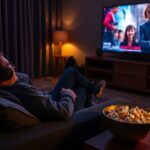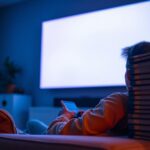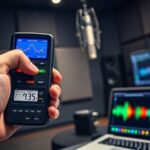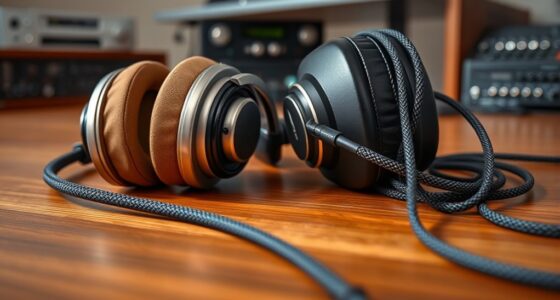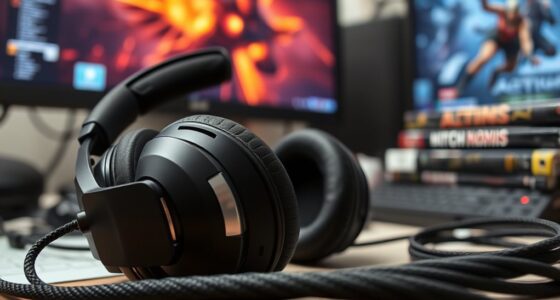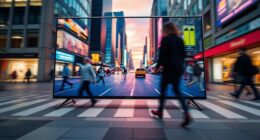To protect your ears, keep the volume at 60% or less of the maximum when using headphones or earbuds, and follow the 60/60 rule—listening for no more than 60 minutes at a time. Use noise-canceling headphones or earplugs in loud environments to reduce sound levels. Taking regular breaks and being aware of signs like ringing or muffled hearing can prevent damage. Continue exploring for more tips to keep your hearing safe.
Key Takeaways
- Keep headphone or earbud volume at 60% or less of maximum to prevent hearing damage.
- Follow the 60/60 rule: listen at 60% volume for no more than 60 minutes daily.
- Use noise-canceling headphones or earplugs in noisy environments to reduce the need for high volume.
- Take regular breaks to give your ears rest and avoid prolonged exposure to loud sounds.
- Be alert to signs of overexposure, such as ringing or muffled hearing, and reduce volume immediately if experienced.

Have you ever considered how essential ear safety is? Your ears are delicate and critical for communication, navigation, and enjoying your favorite sounds. Yet, many people overlook how easily noise exposure can damage hearing over time. By understanding safe listening practices and using appropriate hearing protection, you can safeguard your ears from long-term harm. Noise exposure from loud environments, whether it’s concerts, construction sites, or even headphones at high volume, can cause irreversible damage if neglected. That’s why establishing and adhering to recommended volume levels is essential.
The first step in ear safety is becoming aware of safe listening practices. Experts suggest keeping the volume at 60% or less of the maximum when using headphones or earbuds. Listening at higher volumes for extended periods greatly increases the risk of hearing loss. The rule of thumb is the 60/60 rule: listen at no more than 60% volume for no longer than 60 minutes at a time. If you’re in a noisy environment, instead of turning up the volume, consider using noise-canceling headphones or earplugs. These hearing protection devices help reduce the impact of loud sounds, allowing you to listen at safer levels without sacrificing sound quality. When exposed to loud noise for prolonged periods, your ears need a break. Giving your ears regular rest periods helps prevent fatigue and reduces the risk of damage.
Understanding safe volume levels also involves recognizing the signs of excessive noise exposure. If you notice ringing, muffled sounds, or difficulty hearing after being in a loud environment, it’s a clear sign that your ears have been overstimulated. Immediate steps include removing yourself from the noise and giving your ears time to recover. Regularly using hearing protection such as earplugs or earmuffs in noisy settings can drastically reduce noise exposure, especially in occupational or recreational environments. Proper hearing protection acts as a barrier, muffling loud sounds before they reach your eardrum. This is especially important if you work in noisy industries, attend loud events, or engage in hobbies like shooting or motorcycling. Additionally, harmful pollutants like VOCs and particulate matter can also affect ear health indirectly by impacting overall respiratory and ear health, making protection and awareness even more important.
Frequently Asked Questions
How Do I Know if My Headphones Are Too Loud?
You’ll know your headphones are too loud if you experience ringing, muffled sounds, or discomfort. To prevent this, use volume calibration on your device and consider noise isolation techniques to avoid increasing volume in noisy environments. If you find yourself needing to turn the volume up excessively to hear clearly, it’s a sign it’s too loud. Keep the volume at a safe, comfortable level to protect your hearing.
Are There Safe Listening Limits for Children?
Imagine your child listens to music at moderate volume levels, staying within recommended volume guidelines. For children, safe listening limits mean keeping volume below 60% and limiting listening time to about an hour daily. Excessive volume can harm child hearing over time. You should monitor their headphone use closely, choose volume-limiting devices, and encourage regular breaks to protect their hearing health effectively.
Can Volume Levels Affect Tinnitus Development?
Yes, high volume levels can increase your risk factors for developing tinnitus. Loud sounds can damage your inner ear hair cells, leading to ringing or buzzing. To prevent this, take measures like lowering volume, using noise-canceling headphones, and taking listening breaks. These preventive measures help protect your hearing and reduce the likelihood of tinnitus developing over time. Stay aware of safe listening habits to keep your ears healthy.
How Often Should I Take Hearing Breaks?
You should take hearing breaks every 60 minutes during noise exposure to prevent hearing damage. Think of your ears like a sponge; if you keep soaking it without letting it dry, it gets overwhelmed. Regular breaks allow your ears to recover from loud sounds, reducing the risk of tinnitus. Staying mindful of noise exposure and giving your ears time to rest helps preserve your hearing health long-term.
Does Age Influence Safe Volume Levels?
Age does influence safe volume levels because age-related hearing loss can make your ears more sensitive or vulnerable. Younger people with developing auditory systems should avoid higher volumes to protect their auditory development, while older adults may need to be more cautious due to age-related hearing loss. Always listen at moderate levels, regardless of age, to prevent damage and preserve your hearing health over time.
Conclusion
Protecting your ears is like tending a delicate garden; once damaged, it’s hard to restore. Keep your volume levels within safe limits and take breaks to let your ears breathe. Think of your hearing as a precious instrument — when you nurture it carefully, it will serve you well for years to come. Don’t wait until the silence becomes deafening; prioritize ear safety now, and enjoy the sounds of life without regret.



